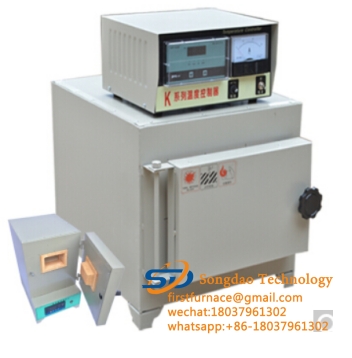- 27
- Jan
Introduction to the new structure of box-type resistance furnace
Introduction to the new structure of lub thawv-hom ua haujlwm rauv
Box-type resistance furnace yog ib hom hluav taws xob rauv hluav taws xob, muab faib ua ntsug, kab rov tav, sib cais thiab sib xyaw. Qhov ntsuas kub tau muab faib ua qis dua 1200 degrees, 1400 degrees, 1600 degrees, 1700 degrees, 1800 degrees, thiab lwm yam, raws li, raws li, siv cov hlau tsis kam, silicon carbide rods, silicon molybdenum rods raws li cov khoom cua sov, uas tuaj yeem xaiv raws li qhov xav tau. Lub thawv-hom hluav taws xob rauv feem ntau yog nyob hauv huab cua. Ntxiv rau qhov cua sov, kuj tseem muaj hluav taws xob rauv taws uas tuaj yeem dhau qhov cua thiab tuaj yeem raug kaw thiab nqus tau, hauv ntau hom. Nws yog dav siv nyob rau hauv kev tsim thiab kev sim ntawm ceramics, metallurgy, electronics, iav, tshuaj, machinery, refractory cov ntaub ntawv, tshiab cov ntaub ntawv kev loj hlob, tshwj xeeb cov ntaub ntawv, tsev cov ntaub ntawv thiab lwm yam teb.

Nws yog precisely vim hais tias lub thawv-type resistance furnace yog dav siv, yog li nyob rau hauv cov tsev kawm ntawv, lub chaw soj nstuam, lub chaw soj nstuam, factories thiab ntau lwm yam lag luam, koj tuaj yeem pom daim ntawv thov kev siv hluav taws xob tiv thaiv cua sov thiab iav firing, thiab lwm yam. Nws kuj tuaj yeem siv rau General me me steel quenching, Annealing, tempering thiab lwm yam cua sov kho cua sov. Tau kawg, lub qhov cub hluav taws xob kuj tseem siv tau los ua cov cua kub kub rau cov hlau, ceramics, dissolution, tsom xam, thiab lwm yam. Cia peb saib ntawm kev taw qhia txog kev kho cua sov tshuab qauv:
1. Lub plhaub sab nrauv yog ua los ntawm cov khoom siv txias txias-kuav los tiag steel phaj, thiab qhov saum npoo yog kho nrog cov yas txau tshuab. Lub qhov rooj rau qhov cub txais ib qho kev qhib sab nraud, uas yog rhiab rau qhov qhib thiab kaw.
2. Qhov nruab nrab kub lub thawv-hom tsis kam rauv txais lub qhov cub kaw. Cov khoom cua sov yog ua los ntawm cov khoom siv kauv nrog cov hluav taws xob cua sov alloy hlau, thiab nws nyob ib puag ncig plaub phab ntsa ntawm lub qhov cub. Lub cub tawg kub yog qhov sib xws thiab lub neej kev pab cuam txuas ntxiv thaum tshav kub dissipation.
3. Lub qhov kub-kub tubular tsis kam rauv siv cov raj kub kub combustion, thiab siv cov silicon carbide rods ua cov khoom cua sov rau nruab rau hauv lub tshuab hluav taws xob.
4. Lub thawv kub-hom tiv taus lub qhov cub siv silicon carbide rods ua cov khoom cua sov, uas yog ncaj qha ntsia rau hauv lub qhov cub, thiab qhov kev siv cua sov yog siab.
5. Lub teeb yuag ua npuas ncauj rwb thaiv tsev cib thiab aluminium silicate fiber ntau paj rwb yog siv los ua cov ntaub ntawv rwb thaiv tsev rau cov cua sov kom txo tau cov cua sov thiab thermal conductivity, ua rau cov cua kub loj hauv lub cub tawg thiab ua kom lub sij hawm cua sov luv, tsis tshua muaj qhov kub thiab txias, tsis muaj qhov cub tawg. tus nqi, thiab kev siv hluav taws xob kuj txo qis heev.
6. Box-type resistance furnace controllers are divided into: pointer type, digital display type, and microcomputer multi-band control type. After reading the structure introduction above, I believe you should have an understanding of why box-type resistance furnaces can withstand high temperatures.
